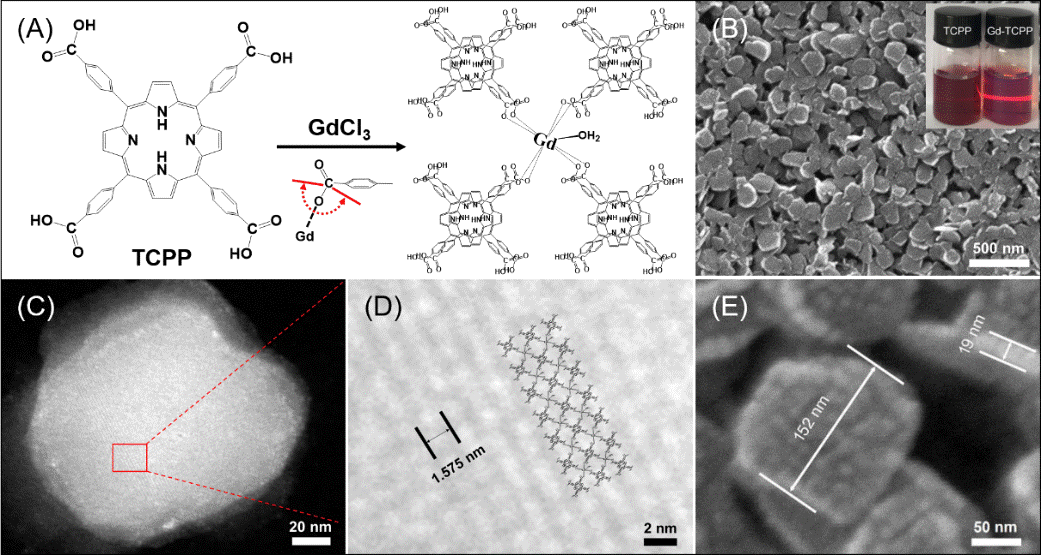Metal-organic frameworks nanosheets, an ideal platforms owing to their tunable structure, good crystallinity, high porosity, and large surface area. These excellent properties led to the application of MOF in gas storage and separation, photocatalytic water splitting, solar fuel conversion, biological imaging, and cancer therapeutics. It is well-known that MOF materials are built up from metal atom nodes and various organic ligands through coordination bonds. The monodisperse and porous nature of the constituent molecules in the MOF structure improves the accessibility of active sites, promotes cross-delivery of energy, and avoids self-quenching. These characteristics provide an idea for us to design nanomaterials with multiple functions.
Magnetic resonance imaging is ideally suited for cancer detection owing to its high spatial and temporal resolution, excellent soft tissue contrast, and noninvasive ionizing radiation. Contrast agents are commonly used to shorten the relaxation time of water protons to provide additional contrast and enhance the sensitivity. However, MRI still suffers from a low rate of relaxation and from the shortcoming of detection and treatment not being performed simultaneously.
In order to achieve the dual effects of MRI imaging and PDT treatment, the Team of the Chinese Academy of Sciences led by Prof. PEI Renjun at Suzhou Institute of Nano-Tech and Nano-Bionics, Chinese Academy of Sciences developed a novel porphyrin-based MOF nanosheets via the combination of gadolinium ions and porphyrin molecules. Owing to the 2D layered periodic porous structure of the prepared MOF, the performance of both metal ions and organic ligands were enhanced in the nanosheets.
As shown in Figure 1, the gadolinium-porphyrin MOF nanosheets were fabricated using the bottom-up method. Through a simple thermal reaction, the Gd-TCPP nanosheets were prepared by coordination chelation between the carboxyl functional groups and Gd ions. The morphology and chemical composition of the prepared Gd-TCPP nanosheets were characterized. Through the comparison and analysis of TCPP and TPPS, the mechanism and molecular structure of the prepared Gd-TCPP products were proposed. Significantly, the Gd-TCPP MOF nanosheets display an excellent relaxation rate of 40.8 mM-1 s-1, which is nearly 10 times higher than that of Gd-DTPA. The high relaxation rate may be ascribed to the enhanced rotation-related time, the reduced distance between the proton of hydrogen atoms and gadolinium ions, and the increased diffusion time of the water molecules. Meanwhile, the Gd-TCPP MOF nanosheets have a high singlet oxygen production capability under illumination owing to their special periodic porous structure. It is postulated that the Gd-TCPP MOF nanosheets have potential application value in MR imaging and PDT treatment owing to their enhanced performance for both functionalities.
This work was titled as “Synthesis of Metal-Organic Framework Nanosheets with High Relaxation Rate and Singlet Oxygen Yield”, and been published on Chemistry of Materials.
 0
0
Figure 1. (A) Schematic of the fabrication of Gd-TCPP nanosheets. (B, E) SEM and (C, D) HAADF-STEM images of the prepared Gd-TCPP nanosheets.(Image by SINANO)
This work was supported by the National Natural Science Foundation of China (21775160), the China Postdoctoral Science Foundation (2018M630618), the National Key Research and Development program (2016YFA0101500) and the CAS/SAFEA International Innovation Teams program.
Contact information:
Prof. PEI Renjun, Suzhou Institute of Nano-Tech and Nano-Bionics, Chinese Academy of Sciences.
E-mail: rjpei2011@sinano.ac.cn
Reference: https://pubs.acs.org/doi/abs/10.1021/acs.chemmater.8b02467

